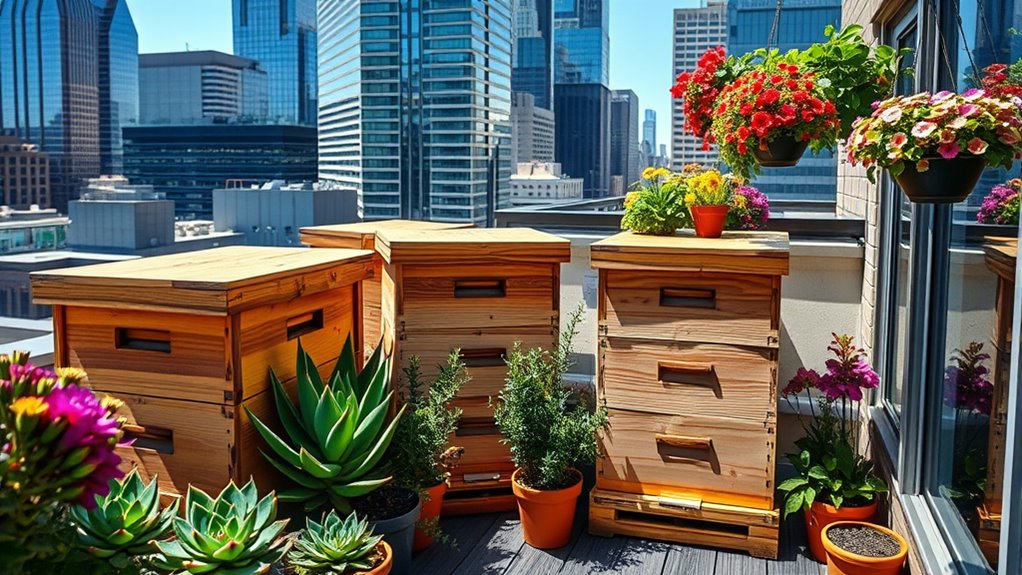To keep bees on your balcony discreetly, you can explore legal loopholes like rooftop or community garden hives, which sometimes bypass ground restrictions. Choose compact, efficient hive designs like Top Bar or vertical models to fit limited space and stay unobtrusive. Use physical barriers and position hives away from neighbors to minimize conflicts. Understanding local regulations and best practices helps you stay compliant. For more tips on managing laws and selecting the perfect hive, consider the options available next.
Key Takeaways
- Exploit ambiguous terms like “beehive” and rooftop exceptions to bypass ground-level restrictions legally.
- Use physical barriers, fences, or screens to guide bees away from neighbors and reduce conflicts.
- Choose compact, vertical, or modular hive designs suitable for small balcony spaces.
- Position hives facing away from high-traffic areas and ensure structural support and wind protection.
- Obtain written neighbor consent and community notifications to strengthen legal standing and minimize disputes.
Navigating Permits and Local Regulations
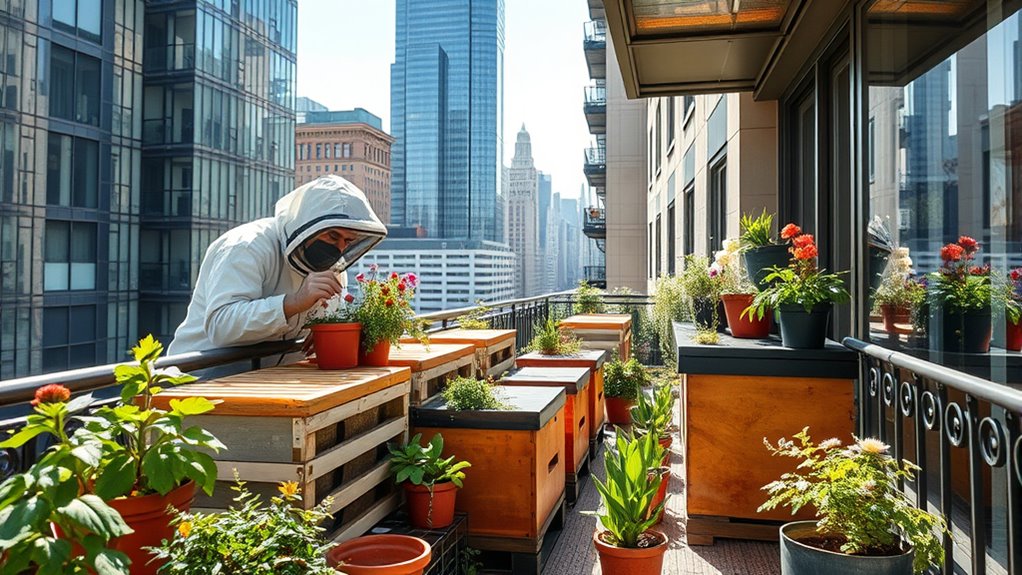
Before starting your urban beekeeping venture on a balcony, it’s essential to understand the permit process and local regulations that govern hive placement. Most cities require a formal permit application, which typically includes a site plan showing hive location and nearby structures or property lines. You may need zoning approval or planning department review. Proof of beekeeping competency or completion of an approved class is often mandatory. Permits usually last one year and must be renewed annually. You’ll also need written consent from property owners or neighbors, especially in multi-family units. Be prepared to provide community notifications and signage. Complete and submit the Honeybee License Application (PDF) to the City Treasurer’s Office. Adhering to these rules helps guarantee your hive stays compliant and avoids penalties, making your urban beekeeping safe and sustainable. Additionally, understanding local regulations can help you identify potential loopholes or exemptions that may facilitate your beekeeping activities.
Exploiting Legal Ambiguities and Creative Solutions
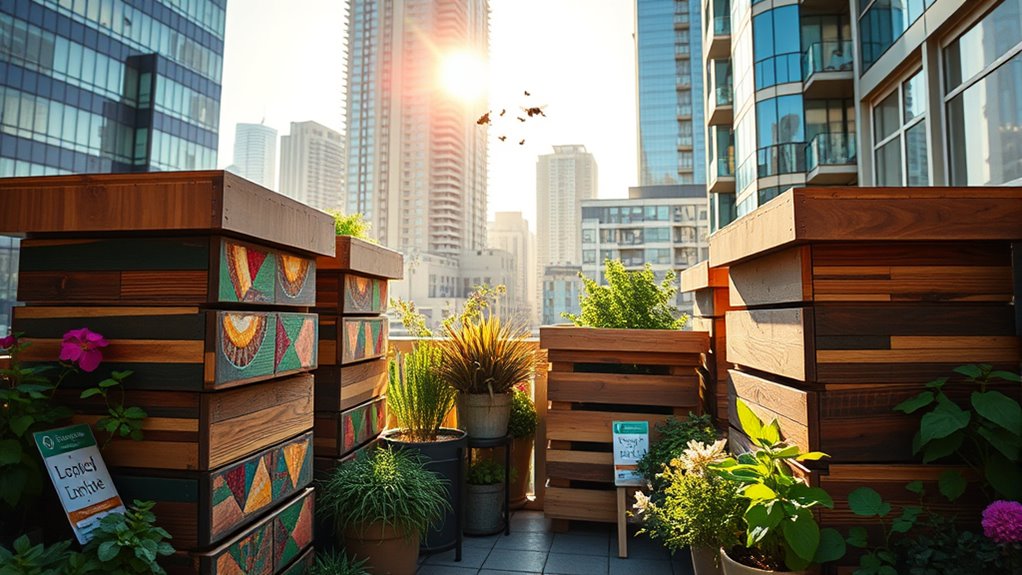
Legal ambiguities in urban beekeeping can present opportunities for creative placement and management, especially when regulations lack specific definitions. You can leverage vague terms like “beehive” or inconsistent enforcement of space rules. For example, rooftop hives often bypass ground restrictions, while physical barriers like fences or screens guide bees away from neighbors. Using less visible spots on balconies or in corners minimizes attention, and shared community gardens can serve as alternative sites. Here’s a quick overview:
| Placement Strategy | Benefit | Consideration |
|---|---|---|
| Rooftop hives | Avoids ground-level restrictions | Check rooftop access laws |
| Physical barriers | Minimizes bee contact with neighbors | Ensure barriers don’t harm bees |
| Less visible spots | Reduces neighbor awareness | Maintain hive health |
| Community gardens | Shared space, legal gray areas | Obtain permissions |
Urban beekeepers often exploit these legal loopholes by choosing locations that are less scrutinized or less regulated, but it’s essential to stay informed about local laws and regulations to avoid legal issues.
Choosing the Right Hive for Limited Spaces

When space is limited on a balcony, choosing the right hive becomes essential for successful urban beekeeping. Opt for compact, efficient designs that maximize space and productivity. For example:
Choosing compact, efficient hives is key for successful urban balcony beekeeping.
- Mini and modular hives fit small areas and can be expanded or adjusted as needed. Modular hives provide flexibility for varying space constraints and hive management.
- Vertical hives save footprint while boosting honey production, perfect for tight spaces.
- Horizontal hives like Top Bar models allow easy management and maintenance without taking up much room.
Additionally, consider visual monitoring hives, such as transparent models, which let you check on your bees without frequent inspections. Material quality is also vital; choose weather-resistant, non-toxic materials like fir or spruce plywood to protect your colony. Select a hive that balances size, accessibility, and durability to thrive in limited spaces.
Implementing Best Practices for Safe and Neighborly Beekeeping
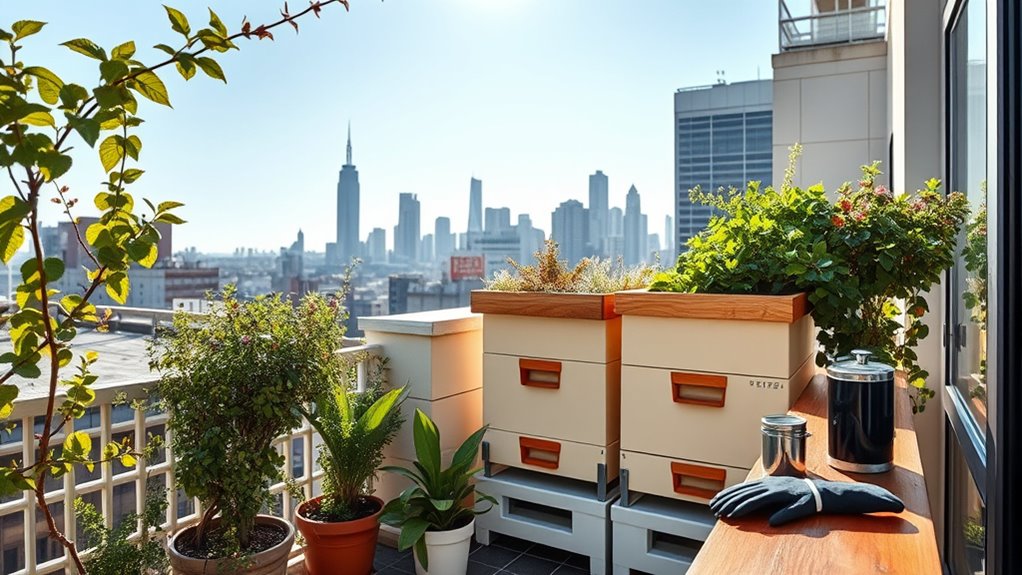
To keep your urban beekeeping safe and neighbor-friendly, you need to follow proper hive safety standards and communicate openly with those nearby. Managing bee behavior through regular inspections and thoughtful hive placement helps prevent issues and reduces conflicts. By staying proactive and respectful, you can enjoy the benefits of your bees while maintaining good neighbor relations. Effective hive placement not only minimizes disturbances but also promotes healthier colonies and better flight paths, further reducing potential nuisances. Understanding local regulations ensures compliance and helps avoid legal issues related to your beekeeping practices.
Maintaining Hive Safety Standards
Ensuring hive safety on balconies requires careful planning and consistent practices to protect both bees and neighbors. First, position hives facing away from busy areas to minimize encounters. Second, use physical barriers like fences, shrubs, or tall plants (around 6 feet) to guide bees upward and reduce horizontal flight near people. Third, select locations that get morning sun to boost bee activity and provide afternoon shade to prevent overheating. Additionally, guarantee your balcony or rooftop can support the hive’s weight and secure it against wind or accidental displacement. Regular inspections are essential for identifying issues early, managing swarm tendencies, and maintaining colony health. Moreover, understanding hive placement principles can significantly reduce potential conflicts and improve hive success. Following these steps helps keep your urban beekeeping safe, legal, and neighbor-friendly.
Communicating With Neighbors
Effective communication with neighbors is essential for maintaining a safe and harmonious urban beekeeping environment. Start by informing neighbors about your hive plans early to prevent surprises. Highlight the environmental benefits, like improved pollination and biodiversity, to foster goodwill. Position hives discreetly to minimize visual impact and respect privacy. Explain bee behaviors and safety measures to address fears and curiosity. Invite neighbors to observe hive inspections safely, encouraging transparency. Share educational information about bees and their importance, correcting misconceptions about aggression and risks. Develop a cooperative approach by seeking input on hive placement and activity times, and consider community events to showcase benefits. Keep neighbors informed with regular updates, and establish open channels for reporting concerns, ensuring mutual trust and respect. Early setup allows neighbors to voice concerns before conflicts arise, fostering a collaborative atmosphere. Additionally, understanding beekeeping regulations can help ensure compliance and prevent legal issues.
Managing Bee Behavior
Managing bee behavior is key to keeping both your hive and neighbors safe and happy. To do this effectively, focus on these best practices:
- Place hive entrances away from high-traffic areas and use barriers like fences or shrubs to encourage bees to fly upward, reducing disturbances.
- Elevate hives on rooftops or balconies to limit ground-level interactions and avoid bright security lights at night that attract and exhaust guard bees.
- Conduct gentle, deliberate hive inspections during spring and summer, watch for pests, and ensure plenty of food stores to prevent stress and defensive behavior. Proper hive placement and management can significantly reduce the likelihood of aggressive encounters.
Recognizing and Addressing Potential Risks
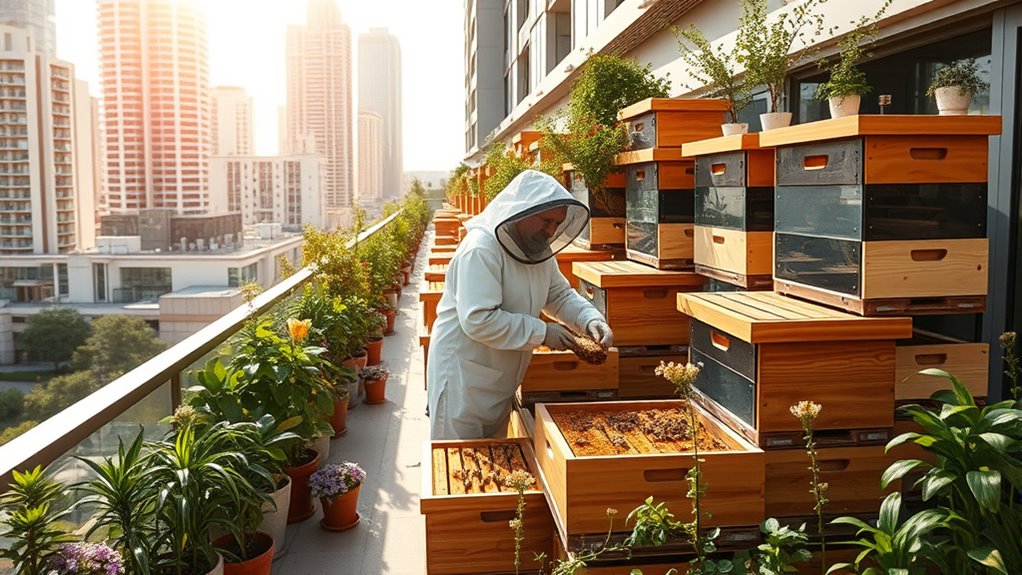
Recognizing and addressing potential risks in urban beekeeping is essential for maintaining healthy colonies and harmonious community relations. Pesticide exposure from city pest control can harm your bees and reduce honey production. To minimize this, choose hive locations away from treated plants and advocate for pesticide-free zones. Environmental pollutants and contaminants also threaten bee health; continuous monitoring helps detect hazards early. Urban areas often lack diverse forage, leading to nutritional stress. Creating bee-friendly gardens on balconies or rooftops boosts nectar and pollen sources. Urban environments can support sustainable beekeeping with proper planning and risk management. Legal challenges, such as unclear regulations and zoning restrictions, can pose risks—staying informed and advocating for clearer policies helps. Finally, safety concerns like stings and swarms require proper hive placement, neighbor education, and safety protocols to prevent conflicts.
Success Stories and Emerging Trends in Urban Balcony Beekeeping

Urban balcony beekeeping is gaining momentum worldwide, showcasing inspiring success stories that highlight its potential to promote sustainability and community engagement. Cities like New York, Berlin, and Tokyo have transformed rooftops and high-rise spaces into thriving beekeeping hubs, fostering local ecosystems and boosting biodiversity. Many of these initiatives include educational outreach and community involvement, further amplifying their positive impact. Emerging trends include: 1. Increased interest in rooftop and balcony hives, making pollinator conservation accessible to residents. 2. Integration of beekeeping with corporate sustainability programs, promoting green spaces and workshops. 3. Development of compact, modular hives designed specifically for small urban areas like balconies. These innovations support urban sustainability efforts and contribute to local food production, create economic opportunities through unique honey, and strengthen community bonds. Overall, urban balcony beekeeping continues to evolve as a crucial part of sustainable city living.
Frequently Asked Questions
Can I Keep Bees on a Rental Balcony Without Owner Approval?
You probably shouldn’t keep bees on a rental balcony without owner approval. Doing so risks violating your lease, leading to eviction or legal trouble. Always talk to your landlord or property manager first, and get written permission. Even if local laws seem lenient, lack of consent can cause problems. It’s best to follow proper procedures, obtain necessary permits, and keep open communication to avoid issues and safely enjoy beekeeping.
Are There Specific Balcony Hive Designs That Avoid Legal Issues?
You’re wondering if certain balcony hive designs can help you avoid legal issues. To do this, choose compact, enclosed, or screened hives that minimize bee flight disturbances and meet setback requirements. Incorporate barriers for neighbor safety, use lightweight, modular materials for easy adjustments, and guarantee easy inspection access. Always check local regulations beforehand, and consider natural barriers like plants to help with legal compliance and neighbor relations.
How Do Noise and Bee Stings Impact Legal Liability?
You might wonder if noise or bee stings could land you in legal trouble. Even a low hum or an unexpected sting can trigger liability if neighbors feel disturbed or harmed. Courts look at whether your hive disrupts their “quiet enjoyment,” and liability increases if someone is stung or complains. To protect yourself, position hives carefully, manage bees responsibly, and educate neighbors—these steps can help minimize legal risks.
What Are the Insurance Considerations for Balcony Beekeeping?
When considering balcony beekeeping, you need to think about insurance carefully. You’ll want liability coverage, ideally up to $1 million, to protect against injuries or property damage caused by your bees. Check if your homeowner’s policy covers hive damages or removal—often it doesn’t. For added protection, consider specialized beekeeping insurance or a commercial policy if your operation grows. Always review policy limits, deductibles, and exclusions to avoid surprises.
Can I Keep Bees if Local Laws Explicitly Prohibit Hives?
If local laws prohibit hives, you shouldn’t keep bees openly, as you risk fines, legal action, and hive removal. However, some options include applying for permits, choosing discreet locations like rooftops or balconies, and ensuring proper setbacks and barriers. Always check local regulations thoroughly, and consider working with authorities or beekeeping groups to explore legal ways to keep bees without violating rules.
Conclusion
As you explore urban balcony beekeeping, remember that over 80% of city dwellers support local bees, making your efforts valuable. Steering permits and choosing the right hive can seem tricky, but with creative solutions, you can thrive responsibly. By following best practices, you not only protect your bees and neighbors but also contribute to urban sustainability. Embrace these trends and turn your balcony into a buzzing haven for pollinators!
I’m Theodore, and I love tiny houses. In fact, I’m the author of Tiny House 43, a book about tiny houses that are also tree houses. I think they’re magical places where imaginations can run wild and adventures are just waiting to happen.
While tree houses are often associated with childhood, they can be the perfect adult retreat. They offer a cozy space to relax and unwind, surrounded by nature. And since they’re typically built on stilts or raised platforms, they offer stunning views that traditional homes simply can’t match.
If you’re looking for a unique and romantic getaway, a tree house tiny house might just be the perfect option.
